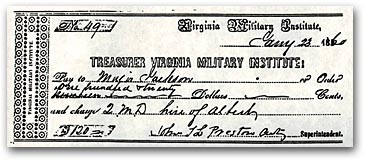Exploring the African-American Experience
in Jackson's Lexington
![]()
In 1851, when Thomas J. Jackson moved to Lexington, over 28% of the population of Rockbridge County and 40% of the population of Lexington was African-American. This figure included 4,100 slaves and 350 free blacks. This temporary exhibit in the Grace P. Heffelfinger changing exhibit room focuses on the slaves of T.J. "Stonewall" Jackson's household, as well as the enslaved and free African Americans he encountered at work, at church, at the homes of friends and family, on the streets of Lexington, and during the Civil War. Visitors have an opportunity to consider the social, economic, and legal climate for black residents of the area during the years before the Civil War.
"Pay to Major Jackson or Order One Hundred and Twenty Dollars and charge Q.M.D. (Quarter Master's Department) hire of Albert,"

While Jackson worked as a Professor at the Virginia Military Institute he hired out Albert, one of his slaves, to the Institute. This voucher, numbered 49, dated "Jany 23, 1860," and signed by John T.L. Preston, Acting Superintendent, documents the transaction:
The exhibit features artifacts associated with slaves and free blacks, including a rare dress that once belonged to a slave who lived on a Rockbridge County farm. Also included in the exhibit is evidence of the legal restrictions upon, work environments of, and educational opportunities available to members of the African-American community in Lexington. Of special interest are the promissory note for the hire of a slave belonging to Jackson, a cast iron hand thought to have been made by a slave who was a skilled artisan at Buffalo Forge, a William Washington painting of an African-American laundress in Lexington and a photograph of the Presbyterian Church Lecture Room where Jackson held a Sunday school for the African-American residents of the area.
The exhibit opened November 30, 2022 and will remain open through October, 1999.
![]()

